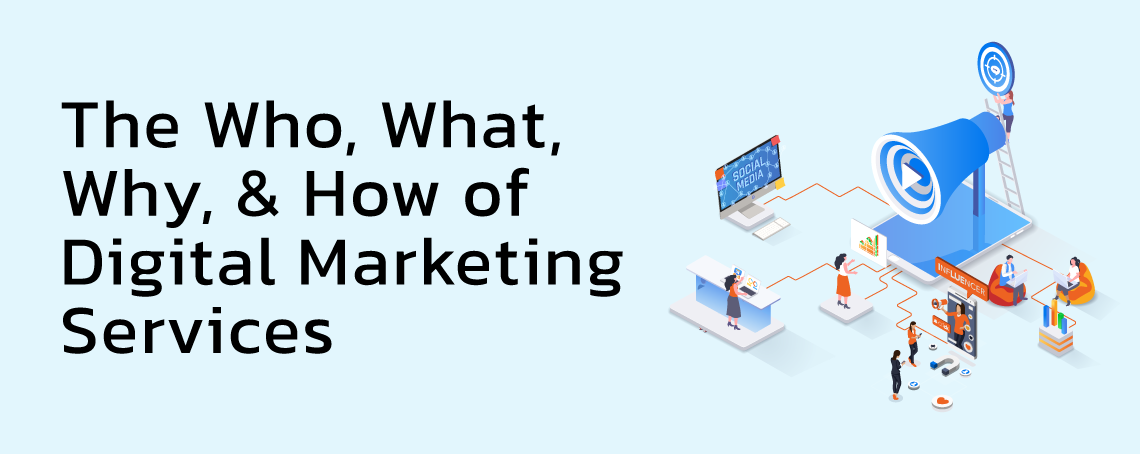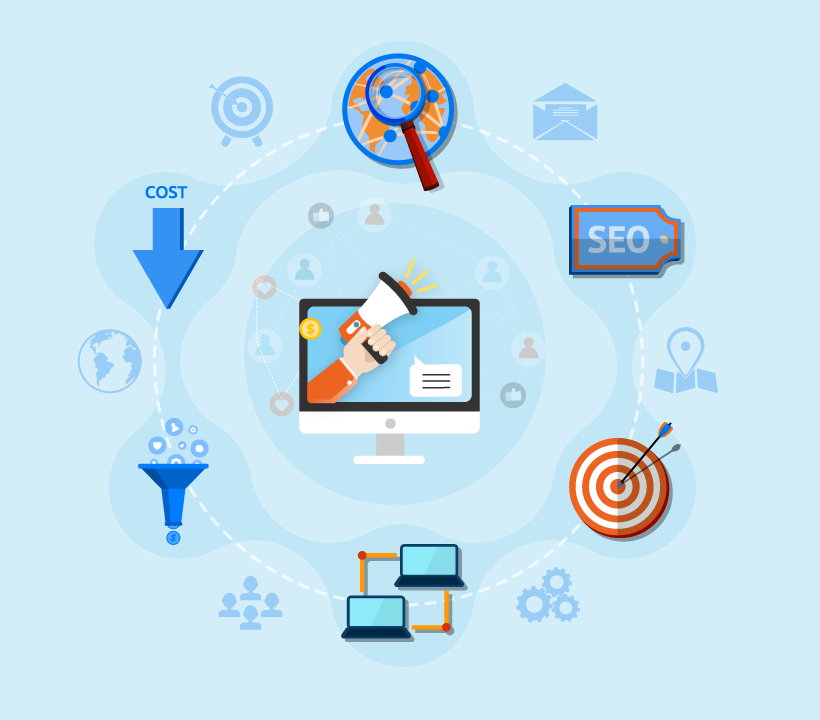What Is Digital Marketing? (Types, Importance & Benefits)

Written by Nevil Bhatt
8 min read

Digital marketing has become an essential aspect of modern business strategies, revolutionizing how companies interact with their customers and market their products or services. It encompasses a wide range of online marketing activities that leverage digital channels to connect with consumers. This article explore the definition of digital marketing, its various types, its importance, and the benefits it offers to businesses.
What is Digital Marketing?
Digital marketing refers to the promotion of products or services using digital channels such as the internet, social media, email, mobile applications, and other digital platforms. Unlike traditional marketing, which primarily relies on print media, television, and radio, digital marketing allows for real-time interaction with consumers and provides measurable results. This shift has been driven by the increasing reliance on digital devices and the internet for everyday activities.
The essence of digital marketing lies in its ability to reach consumers where they spend a significant amount of their time—online. With over 4.9 billion internet users worldwide as of 2023, businesses cannot afford to overlook the potential of digital marketing to engage with a vast audience. Digital marketing strategies can be tailored to target specific demographics based on interests, behaviors, and geographic locations.

Types of Digital Marketing
Digital marketing encompasses various strategies and techniques that can be broadly categorized into several types:
1. Search Engine Optimization (SEO)
SEO involves optimizing a website’s content to improve its visibility on search engines like Google. By using relevant keywords and creating high-quality content, businesses can enhance their chances of appearing in search results when potential customers look for related products or services. Effective SEO strategies not only drive organic traffic but also help establish brand authority.
Search Engine Optimization (SEO) remains the cornerstone of digital marketing, with businesses seeing an average return of $22.24 for every dollar spent. This impressive ROI stems from SEO’s ability to tap into the confirmation bias. Consumers are naturally drawn to information that confirms their existing beliefs or answers their specific questions.
Unlike traditional advertising that interrupts consumers, SEO aligns with their active search intent, creating a psychological foundation for positive engagement. The most effective SEO strategies go beyond keyword optimization to create content that addresses underlying psychological needs.
Creative Implementation Strategy: Instead of simply targeting high-volume keywords, identify the emotional states driving searches. For example, someone searching “best noise-canceling headphones” isn’t just looking for product recommendations, they’re seeking freedom from distraction, peace in chaotic environments, or a way to enhance focus. Craft content that acknowledges these deeper motivations.
2. Content Marketing
Content marketing focuses on creating valuable and relevant content to attract and engage a target audience. This can include blog posts, articles, videos, infographics, and more. The goal is to provide useful information that addresses customer pain points or interests while subtly promoting the brand’s offerings. Content marketing is particularly effective for building trust and credibility with consumers. Content marketing delivers ROI 49% faster than text-based content through videos, making it a critical component of digital marketing strategy.
Unconventional Strategy: Instead of focusing solely on creating content around keywords with high search volume, create content addressing your audience’s most pressing questions, even when search data suggests low volume. This builds trust and cultivates a loyal community that values your insight above competitors.
Psychological Insight: Content that tells stories activates multiple brain regions, including those responsible for sensory processing. This neural activity creates stronger memory imprints than factual information alone. When creating content, structure it as a narrative with tension, resolution, and emotional payoff to make it more memorable and persuasive.
3. Social Media Marketing
Social media platforms like Facebook, Instagram, Twitter, and LinkedIn have become vital channels for businesses to connect with their audience. Social media marketing involves creating and sharing content tailored to each platform to engage users effectively. It also allows companies to run targeted advertising campaigns based on user demographics and interests.
Creative Application: Rather than aiming for viral content (which is unpredictable), focus on cultivating micro-communities around specific interests related to your brand. These smaller, highly engaged groups often provide more sustainable value than massive but disengaged follower counts.
An overlooked aspect of social media marketing is how it can be optimized using the Zeigarnik effect, our tendency to remember unfinished tasks better than completed ones. Create content series that unfold over time, leaving audiences anticipating the next installment, which significantly increases retention and platform return rates
4. Email Marketing
Email marketing remains one of the most cost-effective digital marketing strategies. It involves sending targeted messages or promotions directly to a subscriber’s inbox. Businesses can use email marketing to nurture leads, promote new products or services, share valuable content, and maintain ongoing communication with customers.
Unconventional Approach: Rather than focusing exclusively on conversion-oriented emails, create a balanced sequence that provides genuine value before asking for action. For instance, deliver three purely valuable emails for every one promotional email. This approach builds trust and makes promotional messages more effective when they do arrive.
The anchoring bias can also be strategically used in email marketing by presenting high initial prices that make discounted products seem more attractive. For example, showing the original price alongside the discounted price highlights the savings and creates a perception of value.
5. Pay-Per-Click (PPC) Advertising
PPC advertising allows businesses to display ads on search engines or social media platforms and pay only when a user clicks on their ad. This model provides immediate visibility and can drive targeted traffic to a website quickly. Google Ads is one of the most popular platforms for PPC advertising.
Paid advertising, particularly through Google Ads and social media platforms, delivers a reliable ROI with businesses earning an average of $2 for every $1 spent.
Creative Implementation: Instead of running continuous ad campaigns, create intentional “pulsing” schedules with clearly defined start and end dates. Communicate these timeframes in your ad copy to trigger scarcity bias (“Limited time offer until Friday”). This approach often yields better results than running ads indefinitely.
Lessons from Failed Campaigns
Understanding failure provides valuable lessons for creating successful marketing campaigns. A common pitfall is cultural insensitivity, as demonstrated by H&M’s controversial “Coolest Monkey in the Jungle” campaign featuring a young Black boy. The solution is implementing a diverse review board for all marketing materials to ensure inclusivity and cultural sensitivity.
Another frequent mistake is inauthentic messaging, exemplified by Unilever’s sustainability campaign that didn’t align with actual business practices. The solution is ensuring marketing messages are backed by genuine practices and transparently sharing progress with consumers.
Importance of Digital Marketing
Digital marketing has transformed how businesses connect with their audience, offering a spectrum of advantages that traditional marketing methods often cannot match. By embracing digital channels, companies can achieve more targeted, measurable, and cost-effective marketing strategies.
Precise Messaging for the Right Audience
One of the most notable benefits is the ability to speak directly to groups that share similar interests and values. Instead of using generic messages, companies can create content that is tailored to address specific needs. This strategy reduces uncertainty and makes the audience feel that the conversation is relevant to them. The precision in messaging transforms how brands speak to potential customers, making interactions feel more genuine.
Data and Real-Time Insights
Digital platforms offer an abundance of information about how people interact with content. With careful analysis, brands gain a window into behavioral patterns that may otherwise go unnoticed. These insights allow for adjustments in communication that make the approach feel dynamic and responsive. The real-time nature of this feedback often leads to campaigns that are both flexible and impactful.
The Power of Emotional Engagement
Messages that trigger emotional responses have a profound effect on decision making. By understanding how emotions drive actions, brands can develop campaigns that resonate on a personal level. This strategy uses familiar experiences and feelings to create an atmosphere of trust and assurance. When the audience senses authenticity in the message, it often paves the way for a lasting connection.
Adaptive Strategies That Evolve
Digital channels permit continuous refinement based on ongoing observations. When a particular approach stirs positive feelings, it can be expanded and reinforced. Conversely, if a message does not connect, brands have the opportunity to adjust the tone or content. This fluidity in strategy is a departure from traditional marketing and allows for a more natural, responsive conversation with the audience.
Building Trust Through Meaningful Engagement
The essence of digital marketing is not just about selling a product but about forging a relationship. When messages are created with genuine care, they invite dialogue and encourage active participation. This process builds trust over time and influences decision making by appealing to both emotion and logic. The experience moves away from distant advertising to a form of interaction that feels heartfelt and respectful.
Increased Brand Awareness
With effective digital marketing strategies in place, businesses can enhance brand visibility across multiple online platforms. Consistent messaging and quality content help establish authority in the industry while attracting new customers.
In conclusion, digital marketing transforms communication by creating opportunities for precise, data-informed, and emotionally resonant messages. It redefines the way brands connect with audiences, creating relationships that feel both authentic and adaptive.

Nevil Bhatt
Nevil is the owner of one of the fastest-growing digital marketing agency in India. Having a great knowledge of the IT field and business management, he decided to bring a revolution in the digital world by providing valuable and customised solutions across the globe. Whether it's real or digital, he knows how to handle sustainable relationships and meaningful interactions.




